Natural Gas
What Wednesday’s Vote Means for Dallas, the Shale, and the Rest of the Universe
 Wednesday's vote on the Trinity East permits was not only an historic one. It's a long overdue turning point.
Wednesday's vote on the Trinity East permits was not only an historic one. It's a long overdue turning point.
The bloody knuckle political fight over urban gas drilling in Dallas in 2013 is the fight local environmentalists owed Fort Worth in 2006. Our collective failure in Cowtown gave the gas industry a too-friendly template for every other DFW city that's come after Fort Worth's gas rush.
Wednesday that template got tossed. A clearly frustrated Trinity East lobbyist complained that the company wouldn't even have had to participate in a Council hearing like this one if the same permits were being sought in Fort Worth. Welcome to Big D.
We can't undo old wrongs, but we can start changing the pattern of behavior that keeps churning out new ones. Wednesday's vote by the Dallas City Council was, by far, the highest-profile rebuke of the gas industry in a region it thinks its owns lock, stock and barrel. As he Dallas Morning News put it, "the defeat could be the death knell for natural gas drilling in a city known around the world for its ties to the petroleum industry." Politically, we aren't in Fort Worth anymore.
So what else is new after yesterday? From micro to macro:
From just a basic civics perspective, it's hard not to be impressed with the job that residents did in mobilizing themselves into a persistent and contentious force for change. This wasn't just an environmental victory. It was a victory for grassroots organizing. Residents had to fight not only the gas industry, but Dallas City Hall staff and the Mayor, who were all doing their best to rig the process in Trinity East's favor. Moreover, they had to fight on multiple fronts at the same time, both within the regulatory process to deny the permits outright, and in the Spring's city council elections to make sure they had the votes once the permits got to the horseshoe on Marilla. And oh yeah, they've had to put together and lobby for the toughest regulations to be included in a new ordinance being written, also at the same time.
That said, the last nine months have seen the biggest show of green political muscle in the city's history. If you total up the numbers of people involved, throw in a scandalous secret memo that brings down a City Manager, add triumphs in half the council elections you enter, and pile on winning-over the local conservative daily newspaper, then there's just no comparison. The momentum carried into Wednesday's meeting when opponents got two more votes than the four that were needed to block the permits, for a total of six. That's a far cry from the two or three everyone was sure about when this started last winter. We've seen the Dallas environmental movement grow up right before our eyes into something nobody, including environmentalists, thought it was capable of being when this started.
The fruit of this new growth was on display at City Hall (Coverge from the DMN, KERA, CultureMap and the Observer). There's no precedent for the kind of coalition that turned-out, except maybe the anti-Trinity Tollroad coalition that almost upended the Citizens Council's plans for solar-powered water taxis and riverside freeways in the 1990's. There were West Dallas residents from La Bajada, Oak Cliff dwellers, North and East Dallas homeowners association presidents, Students, teachers, professionals, gas lease owners, environmentalists, neighborhood activists, an Irving city council member, young mothers, young grandmothers and everything in between. Reflecting this diversity was a Council coalition that included both Hispanic Council members, Adam Medrano and Monica Alonzo, African-American Carolyn Davis, newcomer Philip Kingston, and stalwarts Sandy Greyson and Scott Griggs. If this alliance of interests holds together, it stands a very good chance of getting a strong new ordinance in the coming months.
And what about that new ordinance? With the old business of Trinity East now concluded, all attention is directed at Dallas writing and passing the most protective gas drilling ordinance in the Barnett Shale by the end of the year. The chances of that happening went up dramatically with Wednesday's vote.
One of the most unexpected results coming out of the confrontation was Mayor Rawlings' seemingly blunt declaration that he was four-square against urban drilling in Dallas. Saying the city could afford to be picky about the kind of development it seeks, he stated he didn't think gas drilling was a good match for Dallas and looked forward to passing a strong new ordinance. We'll see. Actions speak louder than words, and so far the Mayor's actions on this issue have all been in service to approving the Trinity East permits. With that fight resolved, can he be trusted to embrace a new philosophy? We'll be able to tell soon enough with a draft ordinance due to be delivered by the Plan Commission to the Council in late September. At any rate, his public confession on Wednesday is another sign of how far the Dallas movement has come. It's impossible to imagine Fort Worth Mayor Betsy Price uttering the same words.
It also gives the new members of the City Council some cover to vote for tougher regulations as well. Rumor has it that Jennifer Staubach-Gates was agonizing over the Trinity East vote even as she entered the Council Chambers. She eventually voted with the Mayor but as an ex- school nurse who's dealt with asthmatic kids firsthand, she's concerned about air pollution and other public health consequences of fracking. The Mayor's coming out against drilling in Dallas may embolden her and others to get on the band wagon. Rawlings' statement also sets a high bar for the slew of Mayoral candidates coming up in the next election cycle.
Residents now must focus on the last two Plan Commission meetings and hearings that are deciding what kind of new gas drilling ordinance Dallas will write. And they represent very full plates of issues indeed:
On Thursday, September 12th, at 8:30 am the Commission will begin work on the topics of "Air Quality," "Water," "Pipelines" and "Compressor Stations" in their morning workshop. At 1:30 pm that same day they'll get around to holding another one of their unique (anti-public) public hearings at City Hall on those same subjects. It's vital that residents remain plugged into this process and show up to speak on these incredibly important issues.
Just as opponents all got behind the idea of 1,500 foot setbacks and made it a mantra, we no need to coalesce around three or four central and simple concepts for the 12th including: 1) Air Pollution Off-sets, 2) Special Zoning Districts for Compressors, and 3) much higher water rates for taking water permanently out of the hydrological cycle.
– Off-sets would require that gas operators estimate how much new greenhouse gas (GHG) pollution they'll emit into the air every year based on EPA numbers and their own self-reporting, and then off-set those increases in air pollution by paying for pre-approved air pollution control projects in Dallas that would reduce pollution. If you expect to release 5 tons of emissions from your gas operations, you will have to pay for reducing five tons of air pollution in the city by electrifying a car fleet, improving energy efficiency measures in homes and buildings, putting more bikes on the street and so forth. In this way, off-sets also act as a strong incentive to decrease emissions as much as possible at the sources themselves. The less you pollute i nthe first place, the less you have to pay to off-set that pollution.
Unlike every other heavy industry that does business in a smog "non-attainment" area such as DFW, the gas industry is exempt from having to do this at the federal level. So we want Dallas to be the first city in the nation to fix that loophole by requiring local off-sets. This would be a precedent-setting piece of policy-making that citizens could then take to other Barnett Shale cities and counties. A grassroots regional policy could grow out of the Dallas template – much like it did when Dallas passed the first "green cement" procurement policy in 2007. That campaign lead to the eventual closing of all seven old wet kilns in Midlothian and millions of pounds of air pollution permanently eliminated. It forced the cement industry to clean up. We want to do the same thing with the gas industry and offsets.
This new policy could be the beginning of a tool that we can use to significantly reduce gas industry air pollution, not only in DFW, but in smoggy metro areas throughout the U.S. that now also host gas drilling, like Denver, Pittsburgh, and Los Angeles.
– Compressor Stations are the big league polluters of the natural gas fuel cycle, running 24/7 365 days a year and emitting voluminous amounts of air pollution. Some compressor stations release more Volatile Organic Compounds than the Midlothian cement plants and they're huge greenhouse gas polluters. A recent study from the Houston Advanced Research Center found that a single flare or compressor could raise downwind smog levels by 3-5 parts per billion or more within five miles. Compressors should be required to get their own Special Zoning District with strict rules on sound, pollution and setbacks.
– Water is precious in NorthTexas and industries that take it permanently out of the hydrological cycle should pay more than those that don't. A lot more, because it means we have to go out and find that water anew. Likewise, during drought conditions, water should be for drinking, not fracking. It's critical we make the industry pay for the real costs of using so much of this absolutely necessary resource and then throwing it away for good down a hole.
On Thursday September 26th the Plan Commission will hold its final public hearing on the new gas ordinance. Then it will vote on a draft to send the City Council. Again, citizens need a good turnout for sending this document off, whether it has everything in it we want, or it's lacking in some important way. We need to be there.
We are only these two September hearings away from showing up at the Dallas City Council with the most protective gas drilling ordinance in the Barnett Shale and providing the region and the country a new alternative for the obsolete Fort Worth model.
If you came down to City Hall, if you e-mailed, or phoned or wrote – Thank you for your contribution to the fight. It took exactly the amount of effort you and everyone else gave to make Wednesday's victory happen. It will take it again to pass a great ordinance.
But stick with us. We're making history.
Morning News Takes Strong Stand Against Trinity East Permits; Only 24 Hours to Send Your E-Mails of Opposition
 It's become so common place these days that you're likely to take it for granted, but if you'd ask activists three years ago whether we'd end up carrying the Dallas Morning News on the issue of urban gas drilling, you would have been considered a dreamy-eyed do-gooder.
It's become so common place these days that you're likely to take it for granted, but if you'd ask activists three years ago whether we'd end up carrying the Dallas Morning News on the issue of urban gas drilling, you would have been considered a dreamy-eyed do-gooder.
But in fact, across the board, from Trinity East to the new ordinance, from compressors to setbacks, the News editorial page has been leading public opinion in favor of common sense, transparency and caution ever since the City's Task Force began meeting in 2011.
That leadership continues with today's blunt recommendation to deny the Trinity East permits. Below is the entire editorial in its entirety, which contains as good a synopsis and talking points about the situation as you'll find.
Meanwhile we only have 24 more hours to fill-up the City Council's mail boxes with your messages of opposition to these awful permits. Please click here to take you to our automatic e-mail system or see this alert for the Council's e-mail addresses. Then join us downtown at City Hall tomorrow afternoon at 12:30 pm for the historic vote and come celebrate with us at Lee Harvey's afterwards.
Editorial: Dallas City Council, vote no on gas drilling plan
After months of sidestepping the issue, the Dallas City Council now must do the right thing Wednesday — deny Trinity East’s application for permits to drill on parkland and flood plains around the Elm Fork of the Trinity River.
This shouldn’t be a difficult vote. The Dallas Plan Commission twice considered and rejected the permit application — the correct vote because existing city policy bars drilling on the surface of parkland. Now the City Council should step up and also reject Trinity East’s proposal.
In 2008, the city sold lease rights to drill on city-owned land to Trinity East for $19 million and used the money to help balance the budget. It was an ill-conceived decision, prematurely pushed through for budgetary reasons before city officials had decided how they would regulate drilling within city limits.
Due to low prices for natural gas, the project remained dormant until Trinity East revealed plans late last year to build a compressor station and drill on the surface of parkland. The controversy heightened this spring when news broke that former City Manager Mary Suhm had privately told Trinity East she would help it win the right to drill on parkland at the same time she was publicly assuring the council that she would not support drilling on city parkland. The proposal became such a tangled mess that this editorial board sharply criticized City Hall for lack of transparency and due diligence and urged denial of Trinity East’s application.
Trinity East needs 12 of the 15 council votes to override the Plan Commission decision and grant the drilling permits. Council members Scott Griggs, Philip Kingston, Sandy Greyson and Adam Medrano are solidly on record against the proposal, and at least two others, Carolyn Davis and Monica Alonzo, indicated in The Dallas Morning News Voter Guide last spring that they opposed gas drilling.
We hope the council has learned from this debacle and will deliver a “no” vote Wednesday.
The Trinity East proposal is the wrong plan at the wrong time. Before City Hall considers another drilling proposal from any company, officials must transparently develop a tough new drilling ordinance that protects Dallas neighborhoods. The Plan Commission is in the process of writing an ordinance that, among other things, we hope provides safe setback distances from homes and schools, addresses water use in droughts and continues the ban on gas drilling on the surface of parkland.
Gas drilling can be done safely in an urban area if the proper safeguards and setbacks are adopted. Dallas needs to deny the Trinity East plan and then take the time to write rules that are in the best interest of all residents.
Final Trinity East Gas Permit Showdown: Send an e-mail Now, Testify on Wednesday, and Then Celebrate After the Historic Vote
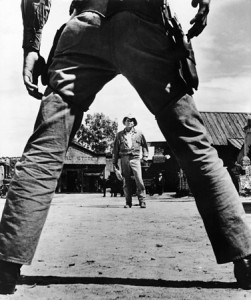 This Wednesday, August 28th, sometime after lunch, the Dallas City Council will finally decide the fate of the three Trinity East gas permits that have refused to die since they were foisted on residents by Mayor Rawlings just after Thanksgiving. This looks to the definitive last nail in the coffin of the "Zombie Permits" that are so bad, even the considerable contorting of the permitting process by the Powers-That-Be could not save them from not one, but two denials by the City Plan Commission.
This Wednesday, August 28th, sometime after lunch, the Dallas City Council will finally decide the fate of the three Trinity East gas permits that have refused to die since they were foisted on residents by Mayor Rawlings just after Thanksgiving. This looks to the definitive last nail in the coffin of the "Zombie Permits" that are so bad, even the considerable contorting of the permitting process by the Powers-That-Be could not save them from not one, but two denials by the City Plan Commission.
Council members Adam Medrano, Scott Griggs, Philip Kingston, and Sandy Greyson have all committed to voting against the permits. Normally that would mean defeat in a 15-member Council, but since the Plan Commission voted to deny, the rules say it takes a super-majority of 3/4 of the Council to overturn such a denial. With these four council members on our side, we have exactly the number to prevent a super majority of approval, with no room to spare.
So we need your help again to make sure this happens and that this is the last time we call folks out to fight these very bad permits. We're asking you to do three things:
1) Spend 30 seconds sending an e-mail to all 15 Dallas City Council members that urges them to vote against the permits on Wednesday. Since we only have about 24 hours left before the vote, please do this now by stopping by our "Featured Citizen Action" page here.
This form e-mail has some good talking points for Wednesday but you can also add your own comments at the end if you like.
If you don't want to use that system, please feel free to compose your own e-mails and send them to the council at these addresses:
jerry.allen@dallascityhall.com, District11@dallascityhall.com, jennifer.gates@dallascityhall.com, monica.alonzo@dallascityhall.com, tennell.atkins@dallascityhall.com, dwaine.caraway@dallascityhall.com, carolyn.davis@dallascityhall.com, sandy.greyson@dallascityhall.com, scott.griggs@dallascityhall.com, vonciel.hill@dallascityhall.com, sheffield.kadane@dallascityhall.com, adam.medrano@dallascityhall.com, rick.callahan@dallascityhall.com mike.rawlings@dallascityhall.com, philip.kingston@dallascityhall.com,
But time is of the essence. Please do this right now. Let's make sure they know we're still watching them.
2) Come down to City Hall at 12:30 pm and be prepared to tell the City Council why these permits should be denied. Since the permits are regular agenda items, anyone can can sign-up and speak about them for 2 minutes each. We need a lot of speakers to balance out what we expect to be another attempt to turn out folks from the industry. It's late-breaking concern over what Dallas is doing is the highest compliment to the effectiveness of your work so far. Don't let it go for naught by taking this last piece of action for granted. This is the first vote by a Dallas City Council on gas permits. It's the first time any of these Council members will have voted on anything to do with gas drilling. It's a landmark vote. We need you to be there to demonstrate not only your widespread opposition to the Trinity East permits, but your support for a much stronger gas ordinance. This is the same council that will be receiving the final draft of the new gas drilling ordinance in just a month.
With these Trinity East permits, there is always the chance of last-minute skullduggery by the Mayor and staff to try and win approval by applying heavy pressure about lawsuit threats etc. We need you there in numbers to prevent such a last-minute move from being successful, or as a last-resort, to raise Holy Hell if it does.
3) Come Celebrate a Citizens Victory. After what we hope will be a victorious vote Wednesday afternoon, you're invited to drive a few blocks down from City Hall to a nice little bar and restaurant called Lee Harvey's (1807 Gould St Dallas, TX 75215 214-428-1555) to celebrate. Our fight against these permits has seen the modern maturation of the Dallas environmental movement as a force to be reckoned with. We've created the most successful citizens coalition in recent memory. This has been, as the Morning News stated, one of the most important zoning fights in Dallas history, not to mention public health and safety. These kinds of victories are too few and far between not to be officially recognized. We know you've spent a lot of time fighting these permits, now please come spend an hour or so reveling in your success. You deserve it.
However, If something unexpected does occur and somehow the permits are still alive on Wednesday afternoon, we'll need a watering hole close by to debrief and plan, so come on over and plot with us win, lose or draw.
To recap, three easy steps to killing the TrinityEast zombie gas permits:
1) Send an e-mail to the Council right now.
2) Bring your butt down to the 6th floor Council chambers at City Hall again at 12:30 pm Wednesday and show this City Council these permits and their scandal still matters to you. Don't let industry out-organize you now.
3) Bring you butt over to Lee Harvey's after the Council's vote to celebrate or commiserate.
See you on Wednesday. Thanks for all your effort on this issue.
Dallas Gas Wars: Residents 1, Joe Barton 0
 Can we just admit up front that we're disappointed The Man himself didn't show up to personally lead the Charge of the Light Crude Brigade at yesterday's Dallas Plan Commission public hearing on a new gas drilling ordinance? We thought after Wednesday's passionate personal pleas for turnout at the Society of Petroleum Engineers' monthly meeting, Ol' Smokey Joe would surely have the courage of his convictions. Sadly, no.
Can we just admit up front that we're disappointed The Man himself didn't show up to personally lead the Charge of the Light Crude Brigade at yesterday's Dallas Plan Commission public hearing on a new gas drilling ordinance? We thought after Wednesday's passionate personal pleas for turnout at the Society of Petroleum Engineers' monthly meeting, Ol' Smokey Joe would surely have the courage of his convictions. Sadly, no.
Instead, he left the righteous fight against radical environmentalists to seven or eight heavily-outnumbered industry engineers and attorneys who showed-up and told the Commission that a 1,500 foot setback was tantamount to a ban on drilling in Dallas. Almost to a man, (for they were all men) they accused the extremists of persecuting a trouble-free, non-polluting industry that was guilty of none of the awful things being said about it by their opponents. In particular, they sought to tag the environmentalists as uninformed, as out of touch with research and the facts, as hypnotized disciples of Josh Fox. In doing all this however, they could muster no science of their own.
Given over 20 minutes of time to make their industry's case, not one engineer or attorney working within the industry cited even one peer-reviewed, journal-published health study to support their claim of benign impact on public health or the environment. Not a one.
For some time, and through many a fight, we've seen a common thread of industry criticism of the uninformed civilian. It has its roots deep in the pat-them-on-their-well-meaning-head sexism that greeted women like Rachel Carson and Lois Gibbs. It's grown to include anyone that challenges the industry's own cost-benefit analysis. It accuses residents of being "emotional" instead of rational when they disagree with that analysis by asking too many good questions.
And yet…when it comes down to the crunch, it's the industry representatives who appeal to the emotions the most when they raise the flags of jobs and growth and try to get everyone else to salute. It's the industry reps who do the most name-calling and make the most personal charges characterizing their opponents. Call it the Foxifying of industry rhetoric. And it was on full display at the Plan Commission on Thursday. Dallas was denying itself untold riches by effectively sealing off thousands of acres to fracking. It would be a devastating to job growth. No actual studies to prove that mind you, but industry assertions should be treated as facts, especially when they're assertion about economic growth – no matter how self-serving.
There was testimony that parks "are some of the best places to drill." That "there was no way" the industry would ever pollute the air or water. The language was absolutist and, dare we say, non-rational and not supported by the facts. At least, they didn't cite any facts to support those assertions yesterday.
And those radical environmentalists Smokey Joe warned about?
As usual, they included Dallas homeowners association members and presidents, people who owned wells themselves or or leased land for drilling, cancer patients, asthma sufferers, 25 year-olds, 81-year olds, Sierra Club members, Downwinders' board members, long-time Dallas residents and people who just moved here, plus a sprinkling of folks from Farmers Branch, Ft. Worth, Garland and Irving (30 of 35 speakers in favor of a 1,500 foot or more setback gave Dallas addresses) and a lot of women. One of the starkest contrasts between the two sides during the hearing was gender.
And, again, as usual, their representatives did cite studies. Lots of them. Because we've been through this before, because we know we'll be accused of being uninformed civilians, we know what's coming and we load for bear. The most comprehensive epidemiological study in a gas field to date showing increased cancer risks. Check. The most recent CDC study on silica pollution at well pad sites showing ever site tested exceeding federal limits by magnitudes. Check. USGS studies of the small earthquakes caused by fracking and the large ones caused by injection wells. Check and check. Proximity to benzene sources raises Leukemia risks. Check. NOAA study on actual methane releases from gas field being twice industry estimates. Check.
Were there appeals to preserve a good quality of life, clean water and cleaner air? Of course. But in most instances these were backed up by specific facts about fracking that challenged those goals. So that at the end of the day, not only was the Light Crude Brigade outnumbered, they were out-researched by the very bunch of know-nothings they were charging with the crime of misinformation. Most of them women.
That sweetly ironic resonance was the anti-climatic capping of a full day's worth of work for the Commission that included an affirmation of the 1500 foot setback originally agreed to back in June by lunchtime. All of the rhetoric back and forth in the public hearing was over an issue that had been argued and decided behind closed doors in Executive Session some five or so hours before. (You can follow the blow-by-blow live blogging of the Commission's morning meeting at our group Facebook site here, and read accounts of the decision in the DMN, Business Journal, & Observer,)
Winning the second affirmation of the 1500-foot setback at the Commission level now is no small accomplishment, especially since we had staff working against us. Dallas would be the largest city, by far, in the Barnett Shale to adopt such a lengthy setback (Fort Worth has only a 600-foot requirement, with variances even lower than that). As our Vice President might say, it's a BFD.
So if you sent an e-mail to the Commissioners this last week, we thank you very much, because that was the only direct advocacy they saw on this issue from our side before yesterday's decision to stick with 1500 feet was made.
But we've only won this provision as long as we can protect it. That's why it was good to come down to City Hall yesterday and support it anyway. Many of the speakers brought up the example of the last-minute Task Force rollbacks that occurred almost two years ago. With the same staff people who tried to scuttle the 1500 foot agreement still in charge of the ordinance-drafting process and rumors of some vague land swap with Trinity East still floating around, we all need to stay vigilant. And of course, if it reaches the City Council as an official recommendation there's no doubt it will come under fresh attack. But if we can hold it at the CPC, it will make it hard for the Council to change it. That's why it was important to show up yesterday afternoon. Thanks very much to everyone who did.
Another Commission public hearing on the new gas ordinance is scheduled for September 12th in the afternoon – but once again, it's scheduled after the regular zoning cases are heard so no certain start time will be available other than 1:30 pm. It will concentrate on Air and Water Quality issues, as well as compressors – a subject never broached by the Task Force. We'll be working with our allies in the Dallas Residents at Risk alliance to get information on these issue areas to you, so that you'll once again be able to talk circles around the industry. Stay tuned.
And of course next Wednesday, August 28th will see a final vote on the Trinity East permits we've been battling since right after Thanksgiving. Thanks to the work of council members Scott Griggs, and Philip Kingston, who stopped by and gave a good pep talk to the troops before the hearing began, we believe we have the four council votes it will take to uphold the Commission's denial, but we need your help in bringing other, more reluctant members on board the band wagon. Beginning Monday, Downwinders' featured Citizen Action will be e-mails to the Council, urging them to vote to deny the permits.
After Wednesday's expected final Trinity East permit denial at Dallas City Hall, we're going to have a party to celebrate what is among the most important victories for public health and the environment in Dallas history. We don't know where and we don't know when, but such victories are too few and far between not to officially recognize. Please keep your calendar that night open.
Yesterday's Commission vote was a skirmish, inside a battle, inside a larger war with many fronts. But it was a critical skirmish. And residents won. Next week, we'll bury very bad and unethical gas permits that were "a done deal" as recently as March. Then we'll only have the new ordinance on which to focus.
Slowly but surely, we're doing what we said we would – drawing a line in the Shale in Dallas and stopping the steamroller of industry favoritism that's resulted in so much bad policy and public health harm elsewhere in the region. Dallas is becoming the place where the bad stuff stops rolling east and the good-thinking begins rolling back west. See you on Wednesday.
Joe Barton Rallies Gas Industry for Today’s Dallas Public Hearing on New Ordinance; Councilman Kingston to Address Citizens at 1pm
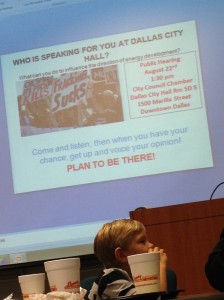 Well lookey here, Ol' Smokey Joe himself was out trying to fire-up the troops in the oil and gas industry yesterday at the monthly meeting of the Dallas chapter of the Society of Petroleum Engineers.
Well lookey here, Ol' Smokey Joe himself was out trying to fire-up the troops in the oil and gas industry yesterday at the monthly meeting of the Dallas chapter of the Society of Petroleum Engineers.
The theme of the talk was "Hydraulic Fracturing: Shattering the Radical Environmental Lobby, Unlocking America's Energy Future" and a lot of the time was spent trying to convince the audience they needed to show-up at today's Dallas Plan Commission public hearing on a new gas ordinance to counter those wacky citizens who think living immediately next door to a billowing plume of diesel smoke and dust is a bad idea. Of course, having not attended any of the commission meetings for the past year or so when the topic has come up more than once or twice, their slide show didn't have any real pics of Dallas residents, so they had to use pics from demonstrations elsewhere, like the one above. Tsk, tsk,
It's also a big stretch to tie the "Radical Environmental Lobby" to what's been going on in Dallas, where there's been no serious mention of a moratorium or ban on drilling, and leading opponents have been members of the Dallas Homeowners Association. But for Joe Barton, the World Wildlife Fund is a Radical Environmental Group.
Audience members were told to come to the hearing at 1:30 pm, but to make sure they spoke last, and "were not polite."
Apparently, citizens have been doing such a good job in Dallas that the industry is now concerned about setting "bad precedents" that won't allow for any drilling in Dallas at all, like the 1500-foot setback that is one of the major issues in contention today.
 You should always use your opponents reactions to events to judge how well you're doing. From the pleas coming from Barton and others yesterday, it's clear Trinity East is out trying to portray itself as some kind of corporate martyr for the cause. They're trying to elevate the Dallas debate over new gas regulations into a proxy for the national fight over fracking. It's a good sign when your opponent begins to panic like this, but it's also a warning that your effectiveness is now under attack.
You should always use your opponents reactions to events to judge how well you're doing. From the pleas coming from Barton and others yesterday, it's clear Trinity East is out trying to portray itself as some kind of corporate martyr for the cause. They're trying to elevate the Dallas debate over new gas regulations into a proxy for the national fight over fracking. It's a good sign when your opponent begins to panic like this, but it's also a warning that your effectiveness is now under attack.
And if Smokey Joe's entreaties aren't enough to get you down to City Hall this afternoon, what about the official debut of new Dallas City Councilman Philip Kingston at the 1:00 pm citizens press conference planned right before the hearing's start? Kingston was elected with the help of many of the same citizens that will be showing up today to testify and has pledged to help write a much stronger gas drilling ordinance. He joins Scott Griggs as leading critics of the Trinity East deal and attempts by the Mayor and Industry to soften the new ordinance.
Industry is getting organized, shouldn't you too? Meet us downtown at City Hall today at 1pm for the press conference and then stick around to say a few words to the Plan Commission on what you want to see in a new gas drilling ordinance. If you can't join us in person, follow the Plan Commission meeting and hearing on the Downwinders' FaceBook site, where we'll be live-blogging the day's events.
Vaguely Reminiscent of the ’70’s: Successful Occupation of British Site Drives Off Frackers For Now
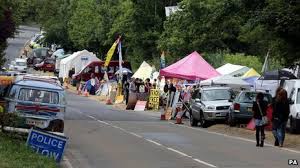 A long time and many galaxies ago, German citizens began occupying the construction site of the Weihl nuclear power plant in hopes of bringing the project to an end. Over 10,000 local residents flooded into the site and established not only an encampment, but an extension of the village itself, complete with school, library and governing council. The idea of such demonstration spread throughout the world, including here in the US, where the Seabrook, New Hampshire occupation in 1977 brought 2000 people out in one of the largest mass acts of civil disobedience in the US, and Texas where there were over over 200 arrests at the Comanche Peak site from 1979 to 1981.
A long time and many galaxies ago, German citizens began occupying the construction site of the Weihl nuclear power plant in hopes of bringing the project to an end. Over 10,000 local residents flooded into the site and established not only an encampment, but an extension of the village itself, complete with school, library and governing council. The idea of such demonstration spread throughout the world, including here in the US, where the Seabrook, New Hampshire occupation in 1977 brought 2000 people out in one of the largest mass acts of civil disobedience in the US, and Texas where there were over over 200 arrests at the Comanche Peak site from 1979 to 1981.
Taking a page from this history, British fracking foes recently established an occupation of a pad site in Balcombe, West Sussex. Approximately 1000 people showed up for at least a six-day "Reclaim the Power Camp" that resulted in energy firm Cuadrilla suspending its operations until "it is safe " to resume them. Yes, nothing so frightening as British villagers.
While the original German protests did result in nuclear power plant cancelations, all the imitations since then have realized their power as symbolic protests. In Texas, the arrests at Comanche Peak were used to put the power plant on trial in Glen Rose itself – a trial that resulted in a hung jury and a huge PR victory at the time. Of course, you can recall that symbolic protest next time you drive by the completed nuke south of Granbury.
So far, no US group has adopted the occupation tactic to protest fracking in domestic gas fields, choosing larger mainstream mass legal actions like marches and rallies to express their displeasure instead. But maybe it's time to pick a pad and make a stand.
Send an E-mail to Dallas Plan Commission Today, Turn Out for Setback Showdown Tomorrow
 Thursday's showdown at the Dallas Plan Commission over a 1500-foot setback between gas wells and "protected uses" like homes and schools is picking up steam.
Thursday's showdown at the Dallas Plan Commission over a 1500-foot setback between gas wells and "protected uses" like homes and schools is picking up steam.
After Commission members get lobbied during their morning session by City Attorney Tammy Palomino to "reconsider" their previous support of the extended buffer zone, local municipal Attorney Terry Welch, who's advised Flower Mound and Southlake on their gas drilling ordinances, has agreed to come to the afternoon public hearing and give a detailed presentation defending the distance. He'll also highlight other issues critical to a truly protective gas drilling ordinance, including drilling in parks, full disclosure of chemicals, and requiring first-ever air pollution off-sets of the gas industry.
Welch was a member of the Dallas Gas Drilling Task Force and his presentation of its "minority report" to the full City Council last August drew a lengthy and sustained standing ovation from the audience that even got Mayor Rawlings' attention.
From 8:30 am to 12 noon on Thursday the Plan Commission will continue its March through the construction of a draft gas drilling ordinance, including revisiting the 1500-foot setback provision, and discussing other issues like Emergency Response.
At 1:00 pm, citizens will start to gather for a pre-hearing news conference. At 1:30 we'll go into the council Chambers and wait for the public hearing on the draft ordinance to begin. It's very possible the Commission will have already decided to support or revise the 1500-foot setback by the time the hearing begins – we'll know by the press conference. If we win retention of 1500, then please thank the Commission and tell them what else you think should be included in a new ordinance. If they back down in the face of pressure from Palomino, then be prepared to raise hell and complain loudly. It's bad enough we have to fight a billion-dollar industry. We shouldn't also have to fight city staff that's supposed to be deciding policy based on the public interest, instead of secret agreements.
Remember, a 1500-foot setback for gas wells means a practical end to any attempt to bring back the Trinity East permits if the Plan Commission's denial of them is upheld at next Wednesday's Council vote. It also means fewer Dallas neighborhoods at risk from being fracked at all. This is a big deal.
We really need butts in the seats to show them you still care and they're still being watched. If you can make it down on Thursday, we know your presence will have an impact.
But we also realize that the Powers That Be are making it hard for the public to participate in their public hearings by scheduling them only during weekday business hours.
So whether you're planning on showing up or not, we've made it easy for you to let the Commission know before Thursday morning how you feel about any reconsideration of the 1500 foot setback. In less than a minute, you can click and send an e-mail to the Commission members supporting the extended buffer zone. JUST CLICK HERE. Please do this today so that when we roll into Thursday morning, Ms. Palomino will have to swim upstream against overwhelming public opposition in trying to persuade the Commission to reduce the setback. We win this round, we go a long way toward winning the whole fight. Thanks very much for hanging in there with us.
To the Barricades: 2 Hearings in 2 Weeks to Protect What We’ve Already Won in Dallas
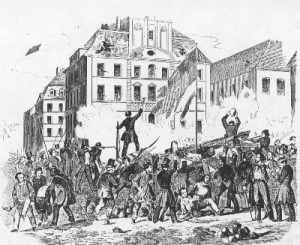 What residents have accomplished in Dallas since last December is nothing short of amazing when you step back for a moment. They took a "done deal" constructed by the Mayor to award Trinity East three gas permits in short order and ground it to a halt. They forced the disclosure of the notorious secret agreement underlying that done deal between the company and City Hall, and in doing so hastened the departure of the City Manager who had been its architect. They repeatedly turned out crowds in the middle of the day for what the Morning News has described as "one of the biggest zoning fights in Dallas history." And they've now begun to construct one of the most protective gas ordinances in the region.
What residents have accomplished in Dallas since last December is nothing short of amazing when you step back for a moment. They took a "done deal" constructed by the Mayor to award Trinity East three gas permits in short order and ground it to a halt. They forced the disclosure of the notorious secret agreement underlying that done deal between the company and City Hall, and in doing so hastened the departure of the City Manager who had been its architect. They repeatedly turned out crowds in the middle of the day for what the Morning News has described as "one of the biggest zoning fights in Dallas history." And they've now begun to construct one of the most protective gas ordinances in the region.
But all of that progress gets put to the test in quick succession over the next two weeks. That why we're putting out the call again.
1. PUBLIC HEARING ON WHAT YOU WANT IN A NEW GAS DRILLING ORDINANCE, THIS THURSDAY, AUGUST 22nd, 1:00 PM DALLAS CITY HALL 6th Floor
This Thursday at 1:30 pm in the Dallas City Council chambers, the City Plan Commission will hold the first public hearing on the draft of a new gas drilling ordinance for the City of Dallas. There will be only two of these before it heads to the full City Council, with the second scheduled for late September right before a final vote by the Commission. So if you want the Commission to understand how strongly you feel about regulating gas drilling in Dallas while they're actually writing the ordinance, you need to show-up this Thursday.
As with previous encounters with Dallas City Hall, nothing takes the place or sends the message as loudly as butts in the seats. Nothing. We know it's a pain to make these work day hearings. They intend them to be. They want to discourage you from showing up. Don't let them.
Please plan on being there in the Flag Room outside the City Council Chambers on the 6th floor at 1:00 pm on Thursday for a pre-hearing news conference with some special guests.
Among the most important things at stake this Thursday is the strong stand taken a month ago by the Plan Commission to impose a 1500-foot setback separating gas wells from "protected uses" like homes and schools. This distance equals what both Southlake and Flower Mound require in their gas ordinances, and is the longest setback currently used by any North Texas municipality.
City staff, led by City Attorney Tammy Palomino, knows that a 1500 foot setback will severely limit the availability of land where fracking is allowed to take place in Dallas. Ms Palomino and company are still trying to produce a weak ordinance that will allow Trinity East, or other operators, to go back to the same areas that were being proposed before – park land, flood plains and new recreation centers. A 1500-foot setback would not allow that to happen. That's why they're trying to scuttle it.
Beginning at 8:30 am Thursday morning – before the public hearing even begins – Palomino will be giving a formal briefing on the setback issue to the Plan Commission aimed at getting the Plan Commission to "rescind" their support for 1500 feet. Staff wants a 1000-foot buffer zone that can be adjusted through "variances" down to only 500 feet – a distance even the Dallas Morning News has called "unacceptable." They want the Commission to vote for a lesser distance even before members hear from the public at the afternoon hearing. That's right, if Attorney Palomino has her way, this issue will have already been decided when you show up to speak at Thursday's afternoon public hearing.
What can you do besides work up a head of steam at the idea of staff once again short-circuiting democracy in this process? Let the Commission members know how you feel before Thursday by sending them a quick click and send e-mail that requests them to stand fast by the 1500 foot setback they've already voted to support. Please spend a minute doing this right now. We only have three days. Click here. Then mark your calendars to be at Dallas City Hall this Thursday at 1:00 pm to make sure we keep what we've worked for up to now. We need you again.
2. WEDNESDAY, AUGUST 28th: FINAL COUNCIL VOTE ON THE NOTORIOUS TRINITY EAST GAS PERMITS
Can we possibly be about to nail the final nail in the coffin of the never-say-dead Trinity East gas permits? Yes. Yes we can.
Two Wednesdays from now, at their regularly-scheduled meeting on August 28th, the Dallas City Council will be voting on whether to uphold the Plan Commission denials of the Trinity East permits – the three permits that have set-off the last nine months of citizen vs staff and council battling at City Hall.
Since the Plan Commission voted to deny the permits (twice, but who's counting?) the council must have a three-fourths majority, or 12 members out of 15, to overturn that denial. At last count, citizens have at least four or five council votes to uphold the denial, meaning the permits would die a final certain death, even if a majority of the council still supports them, as appears to be the case. Here's the tally as of today:
Against the permits:
Scott Griggs
Philip Kingston
Adam Medrano
Sandy Greyson
Uncertain, leaning against:
Carolyn Davis
Monica Alonzo
Uncertain, leaning for the permits:
Lee Kleinman
Jenifer Gates
Rick Callahan
For the permits:
Mayor Mike Rawlings
Jerry Allen
Sheffe Kadane
Terrell Atkins
Dwaine Carraway
Vonciel Hill
As you can see, despite months of overwhelming public opposition, editorial opposition form the Dallas Morning News, and two votes against the permits from its own Plan Commission, residents have exactly no margin of error in this vote. We must have four to win a permanent denial.
As we know more about when the vote is going to be scheduled during the Council's day-long agenda, we'll post it so you don't have to waste all day waiting to speak.
Rumor has it that the City of Dallas hired an outside law firm to assess the lawsuit threat thrown around by Trinity East in case they don't get their permits. What came back was an assessment that said the City wouldn't be on the hook for anymore than the original $19 million paid by Trinity for the six years time on their unexploited leases even if the city lost. But more than this, the outside firm recommended that the city forgo any threat at all and go ahead and award the permits, taking a huge gamble on the company not being able to take drill in the 6 months left on the leases with gas prices so low.
So now council members feel like they've been given permission to vote for the permits, public be damned.
And what if the legal firm is wrong and Trinity East does go ahead a drill by February of next year? Well then the council in its infinite wisdom will have carved out a one-time only, one-operator only special class of gas fracking that violates its own rules about such things and can never be undone.
Last August, residents came together in front of the Council and literally blew away the members with their show of support for a strong protective gas ordinance. We need that kind of showing again, not once, but twice in as many weeks. We need you to stand with us to defend what we've already won. We can't guarantee that your presence will automatically insure victory, but we do know that we can't win the final rounds of these fights without it. Please try to stick with us as we get the job done. Thanks.
Groups: Dallas City Attorney is Blocking Stricter Gas Drilling Ordinance, Call for Independent Counsel
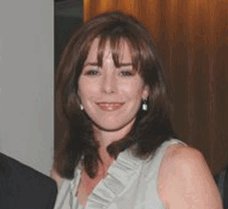 (Dallas)—- Citing City Hall official audio recordings, neighborhood and environmental groups are accusing Dallas City Attorney Tammy Palomino of blocking the City Plan Commission’s intentions to adopt a stricter gas drilling rule governing how far wells can be located from neighborhoods and schools.
(Dallas)—- Citing City Hall official audio recordings, neighborhood and environmental groups are accusing Dallas City Attorney Tammy Palomino of blocking the City Plan Commission’s intentions to adopt a stricter gas drilling rule governing how far wells can be located from neighborhoods and schools.
“It’s a clumsy attempt to steamroll the Commission, made even more embarrassing by the fact that it’s captured on tape,” said Zac Trahan with Texas Campaign for the Environment. “She’s stepped out of her role as an objective advisor, and become an advocate for a much less protective ordinance – even after the Commission made it clear they want a stronger one. Residents can’t trust her.”
In a letter to Mayor Mike Rawlings and the Dallas City Council, Trahan’s group, along with Downwinders at Risk, FracDallas, Dallas Area Residents for Responsible Drilling, Climate Reality Leadership Corps, and the Dallas Sierra Club complained that the evidence of Palomino’s bias was so blatant that the Council needs to appoint an outside lawyer to advise it and the Plan Commission on the writing of the new gas drilling ordinance.
At issue is one of the most important restrictions a municipality can place on gas drilling – the buffer zone or “setback” distance between a gas well and a home, school or other “protected use.”
Currently Dallas allows drilling within 300 feet of those kinds of structures, a holdover from the original 2007 drilling ordinance that is now being rewritten by the Plan Commission. At an earlier June meeting, Commission members reached a consensus to lengthen that distance to 1500 feet, with no objection. But when it was time to recap the results of that meeting, Attorney Palomino denied such a consensus ever occurred as part of the official record.
However, the city maintains audio recordings of every Plan Commission meeting and according to the recording of that June meeting, the intent of the Commission was clear, despite Palomino obvious attempts to get them to back down to a less protective distance. The groups released excerpts from the June meeting:
Commissioner Anglin: “The mandate generally would be, in my view, 1,500 feet generally and a 2/3rd [vote] waiver down to 1,000 feet.”
Commissioner Ridley: “I agree with that.”
Chair Alcantar: “OK, any comments?”
(The audio is silent)
Assistant City Attorney Tammy Palomino: “Commissioner Anglin recommended 1,500 feet, do we need to have more debate on that? Is there a majority that wants to go back to 1,000 feet instead of 1,500?”
Chair Alcantar: “I think we are all in agreement on 1,500…you got that, Tammy?”
Assistant City Attorney Tammy Palomino: “I do…I will draft the changes to the spacing.”
Despite this promise, Palomino showed up at the next meeting with no such changes reflected in the draft. Surprised at the omission, a Plan Commission member quizzed her. Again, the groups point to excerpts from the July meeting:
Commissioner Paul Ridley: “At the last meeting we had a consensus on 1,500 feet. Why is that not reflected in the base draft?”
Assistant City Attorney Tammy Palomino: “Because at the last meeting at the end I said that staff needed to look at that because those numbers are different….from what the task force recommended….and we need to come back and provide information on how that may or may not affect land use….We did not have a consensus on that, either.”
Despite a consensus from the Commission itself to adopt a setback of 1,500 feet, Attorney Palomino is unilaterally vetoing the recommendation in the running draft of the ordinance – a draft that only she is allowed to keep.
“When she says ‘we did not have consensus on that,” she’s not telling the truth” said Jim Schermbeck of Downwinders at Risk. “In fact, the Commission did reach consensus, but it was one that Attorney Palomino didn’t like. Apparently she feels like her vote counts more than all of those on the Commission combined.”
Representatives from the groups say Palomino’s motive is clear – to weaken the new ordinance enough to allow the resubmission of the twice-rejected Trinity East gas permits that have been the center of controversy for the last nine months.
They claim the same thing that’s happening now with the Plan Commission has happened before. According to their letter, “This problem of staff bias towards the Trinity East permits has been omnipresent at Dallas City Hall since the 2007 secret deal between Trinity East and City Manager Mary Suhm was signed. There has been a long trail of contorting the process over the last six years.”
To prevent the same bias from twisting the process this time, the groups request the Mayor and Council appoint outside counsel for the drafting of the gas-drilling ordinance.
The Plan Commission’s next workshop on the gas drilling ordinance is this Thursday, August 8th, beginning at 8:30 a.m. in Room 5ES of Dallas City Hall. The agenda calls for a discussion of a wide range of issues concerning how to regulate drilling in Dallas, including a “review of the draft ordinance” so far, and a revisiting of “previous topics.”
Because of Ms. Palomino’s insistence that the 1,500ft setback has not been decided, the groups expect more debate within in the Plan Commission itself on Thursday in any review of the process-to-date.
Follow-Up: Silica Air Pollution at Fracking Sites Out of Control
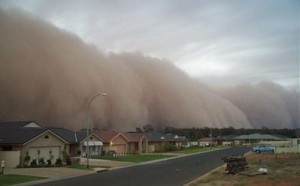 Last summer we told you about a nationwide Centers For Disease Control/National Institute for Occupational Safety and Health (NIOSH) warning to gas and oil field workers about rampant silica air pollution at fracking sites throughout the country. Research had found that pollution standards were being trampled at every site they tested. These were all tests done within the fence line of the well site, so nobody knows what the off-site impacts were/are, or how far downwind they can extend.
Last summer we told you about a nationwide Centers For Disease Control/National Institute for Occupational Safety and Health (NIOSH) warning to gas and oil field workers about rampant silica air pollution at fracking sites throughout the country. Research had found that pollution standards were being trampled at every site they tested. These were all tests done within the fence line of the well site, so nobody knows what the off-site impacts were/are, or how far downwind they can extend.
Now comes a recent follow-up report that breaks down all the information that was the basis of that 2012 industry warning, and its gruesome. Because it's so detailed, we're pasting it in blocks below in one narrative feed.
Fracking uses a lot of sand. There's an entire silica pollution cycle within fracking that's only now getting the attention it deserves. The mining of sand for fracking can take place miles away from the gas or oil plays and threaten new areas never touched by a well. It takes lots and lots of water. There are lots and lots of trucks, and lots of silica in the air at the mine. Just ask the folks along the Red River, to the northwest of DFW in what used to be pristine rolling timbered hill country.
Once it gets to the fracking site, it creates the clouds of silica air pollution that OSHA is so concerned about. The level of exposure the feds found at some of the fracking sites they studied was "enough to overwhelm the maximum use concentration ratings for the half-mask, air-purifying respirators that workers typically wore" while working at the site. Breathing silica is like breathing sand or cement into your lungs. Eventually it fills them up and hardens your air passageways and you suffocate to death. Happens in the cement industry a lot. We know this is a real and current hazard to workers at the site. We have no idea what kind of hazard it is to people off-site. None. Zero. Nada.
This is why regulators must be cautious in deciding things like "setback distances." The difference between 1000 and 1500 feet could be a dramatic drop-off in silica pollution. That could be an important margin of error for public health we need but don't know much about right now.
Here's the story from Robert Iafolla in Bloomberg:
Workers' Silica Exposure at Fracking Sites Far Exceeds OSHA Limit, NIOSH Study Finds
The concentration of silica in the air workers breathe exceeded occupational health criteria at all 11 hydraulic fracturing sites tested by the National Institute for Occupational Safety and Health, the American Industrial Hygiene Association announced July 31.
Researchers measured the silica levels of more than 100 personal breathing zone samples at fracking sites in five states, finding levels above the Occupational Safety and Health Administration's permissible exposure limit (PEL), NIOSH's recommended exposure limit (REL), and the American Conference of Governmental Industrial Hygienists threshold limit value (TLV).
In some instances, the samples exceeded OSHA's PEL by a factor of 10 or more. That level of exposure is enough to overwhelm the maximum use concentration ratings for the half-mask, air-purifying respirators that workers typically wore, the study said.
“Although effective engineering controls for crystalline silica are well established in other industries, controls to limit silica-containing dust generation during hydraulic fracturing are only now emerging due to the relatively recent understanding of the hazard and magnitude of exposure risks,” the study authors wrote.
The study appears in the Journal of Occupational and Environmental Hygiene, published jointly by AIHA and ACGIH.
NIOSH first flagged the occupational hazard of silica exposure at fracking sites in a June 2012 Hazard Alert. The journal article describes the research that informed that alert (42 OSHR 576, 6/28/12).
Silica sand is a crucial and common component in many fracking operations. Silica is often mixed with the water and chemicals injected into shale formations during fracking, with silica acting as a “proppant” to keep the underground fractures open to allow oil or natural gas to flow. Approximately 28 million metric tons of silica sand was used in fracking during 2012, according to the U.S. Geological Survey.
The heavy use of silica is reflected in the air contamination at fracking sites. Just over half of the 111 samples that NIOSH tested exceeded the PEL for silica, while 69 percent exceeded the REL, and 84 percent exceeded the TVL.
OSHA's PEL is calculated from the percent of crystalline silica in the respirable dust; the PEL for 100 percent silica would be 0.1 milligram per cubic meter of air. NIOSH's REL is 0.05 milligram per cubic meter, and the ACGIH's TVL is 0.025 milligram per cubic meter.
OSHA's proposed regulations for silica could lower the PEL to 0.05 milligram per cubic meter, although that has been met with fierce resistance from industry. The proposal has been on hold at the White House Office of Management and Budget since February 2011.
Researchers took samples at fracking sites at five shale formations: Bakken in North Dakota, DJ Basin in Colorado, Eagle Ford in Texas, Fayetteville in Arkansas, and Marcellus in Pennsylvania. The fracking operations at those locations used silica as the proppant, with the exception of the Bakken site, where 60 percent of the proppant was a ceramic material.
None of the 10 samples taken at Bakken exceeded OSHA's PEL. Two-thirds of the samples at Marcellus, 54 percent at Fayetteville, 53 percent at DJ Basin, and 50 percent at Eagle Ford went over the PEL.
Typical fracked gas or oil wells go through 12 to 20 stages, with each stage requiring hundreds of thousands of pounds of sand, creating airborne dust at the sites, the study said.
Sand is delivered from tractor trailers and pumped with compressed air through fill ports into on-site storage and delivery vehicles known as “sand movers.” Those sand movers use motor-driven belts called “dragon tails” to supply sand to blender trucks, with larger loads requiring multiple vehicles moving sand across a transfer belt. Blender hoppers pump the sand-as-proppant through a manifold, piping, and into the well.
Workers operating sand movers and transfer belts are exposed to the highest levels of silica, the study said.
Overall, the study found seven points of dust generation that were common at all 11 sites:
• from “thief hatches” on the tops of sand movers during filling,
• from the sand mover belt,
• from the momentum of falling sand below the dragon tail at the blender hopper,
• from transfer belts when sand is deposited onto the belt and conveyed to the blender,
• from sand leaving the end of the dragon tail,
• from fill ports of sand movers during refilling operations, and
• from truck traffic at the fracking site.
The study said that about 435,000 workers were employed in the U.S. oil and gas extraction industry during 2010, with nearly half employed by well servicing companies, including companies that use fracking.
The study “Occupational Exposures to Respirable Crystalline Silica During Hydraulic Fracturing” is available at http://tinyurl.com/mn5sbc3.
